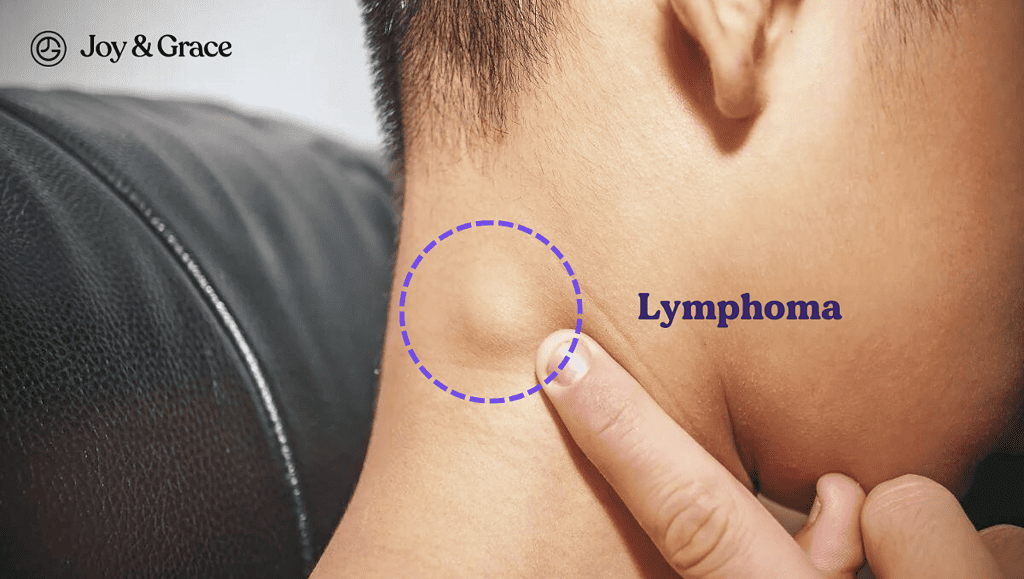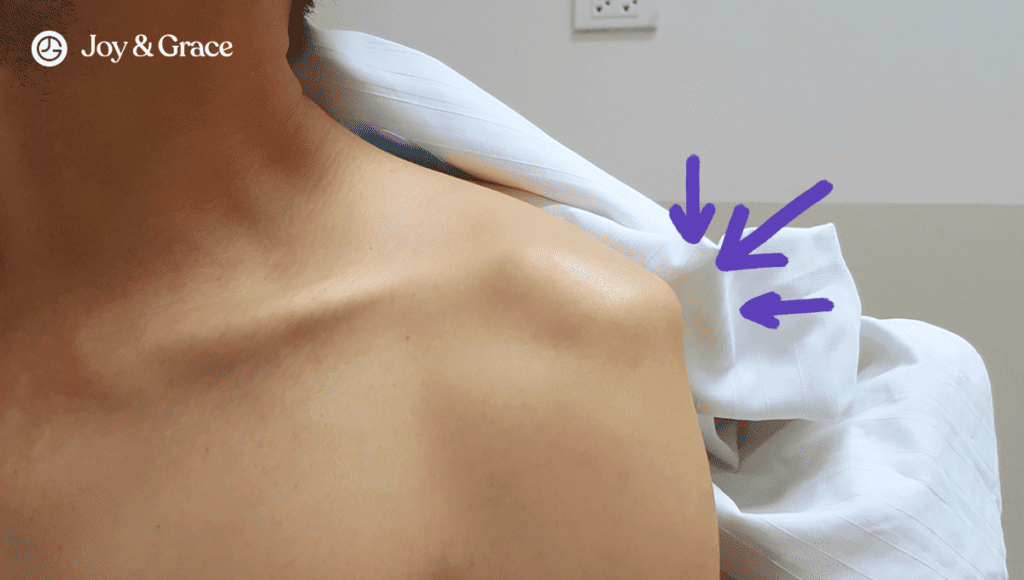Imagine reaching up to snag that one item from the top shelf, and a sudden pang in your arm stops you. You brush it off, believing it to be just another random ache. But then it becomes a regular occurrence. And to make things worse, it’s coupled with numbing or burning sensations.
If this scenario sounds familiar, you might be experiencing arm pain from a pinched nerve in your neck. It might sound odd to link an ache in your arm to your neck, but our bodies are incredibly interconnected. Here’s everything you need to know about this painful condition.
Can A Pinched Neck Nerve Cause Arm Pain?
Yes, a pinched nerve in the neck can indeed cause arm pain. This condition is also known as cervical radiculopathy.
- According to a study, arm pain is the main symptom in 97–99% of patients. Meanwhile, only 56–80% of patients will have neck pain as the main symptom.
Cervical radiculopathy is a condition that occurs when there is compression of the nerve roots in the cervical spine or neck.
To understand how cervical radiculopathy causes arm pain, it's essential to grasp the basic anatomy of the cervical spine.
The cervical spine (the bony column of the neck) is made up of seven vertebrae labeled C1 to C7. Between each pair of vertebrae, there are discs that act as shock absorbers. The nerve roots exit the spinal cord through small openings called neural foramina (from Latin, literally meaning “nerve openings”). These openings are located between each vertebra.
The spinal nerve roots then form the brachial plexus, a network of nerves that extends into the shoulder and down the arm.
If nerves get compressed, they might not work right properly. This results in pain and abnormal sensations along the pathway of the affected nerve. In the case of cervical radiculopathy, this often results in symptoms in the neck, shoulder, and down the arm.
The precise location of the pain depends on which nerve root is affected, which we’ll talk more about later. Cervical radiculopathy usually doesn’t appear on its own and is usually the result of another condition.
What Causes Cervical Radiculopathy?

As mentioned, cervical radiculopathy can result from a variety of causes, including:
- Cervical Spondylosis
One primary cause involves changes to the cervical spine due to age or wear-and-tear, called cervical spondylosis. This can result in the formation of bone spurs, which press against the nerves.
In addition to aging and wear and tear, the following factors can also cause spondylosis:- Osteoarthritis
- Rheumatoid arthritis
- Ankylosing spondylitis
Cervical spondylosis can also cause your intervertebral discs to “slip” out of position. You might know this as a "slipped disc," but the medical term is a herniated disc. In this scenario, the interior gel-like substance of the disc leaks outward, applying pressure to the nerve roots.
- Direct Injury
Another major cause of a pinched nerve in the neck is a direct injury. The vertebra could be hurt in an accident or a fall, which would make the space between them smaller and put pressure on nerves.
Activities that put pressure on your neck, such as heavy lifting or repetitive neck movements, can also worsen the condition. - Non-degenerative causes
More rarely, spondylosis or trauma may not be to blame for radiculopathy. Instead, it can be caused by various non-degenerative factors, including:- Infectious diseases, mainly shingles and Lyme disease
- Infarction of a nerve root,
- the invasion by tumor,
- infiltration by granulomatous tissue,
- demyelination, and
- inflammatory and neurodegenerative conditions
These causes typically present with more severe and additional symptoms, differing from those of degenerative radiculopathy.
How Common Is Cervical Radiculopathy?
Cervical radiculopathy is an exceedingly common condition. It can affect individuals across all ages and is highest in people aged 40–50 years old. According to a journal, it happens at a rate of 85 people per 100,000.
As mentioned above, one of the leading causes is spine degeneration due to aging. However, an abrupt injury can accelerate its occurrence in younger people, making it a condition not limited to age.
Some groups are more susceptible to developing the condition. This includes those who work in repetitive motion professions, like office work or manual labor.
Sports enthusiasts, especially those who perform high-impact activities or contact sports, are also more prone to sustaining injuries that can lead to a pinched nerve. Weightlifting can also increase your risk of having a pinched nerve.
- Smoking
- A pinched nerve in the lower back (lumbar radiculopathy)
- Driving or operating vibrating equipment
What Are The Symptoms Of Cervical Radiculopathy?
Cervical radiculopathy often triggers a series of aches radiating from the neck down to the arm. Most likely, the first symptom you might encounter is pain in the neck. It usually affects only one side and can travel to the shoulder and arm of the same side.
Aside from neck and arm pain, a pinched nerve in the neck can also cause sensory (“feeling”) disturbances. These include:
- Numbness
- Burning
- Tingling
- Muscle weakness
Like pain, these sensory symptoms can also extend from the neck, down the arm, and even to your fingers. The pattern and pathway of the pain and sensory symptoms serve as a map and can help pinpoint the irritated nerve root.
Other symptoms include:
- Headaches
- Loss of reflexes
Because of this, a pinched nerve can mimic numerous conditions, making a proper medical evaluation important.
What Does Cervical Radiculopathy Pain Feel Like?
Cervical radiculopathy pain might differ from person to person. Most people often describe the pain as a sharp, shooting, or burning pain that travels down the arm.
However, some people also describe the pain as a dull ache, often mistaking it for muscle soreness or tension. Furthermore, the pain can worsen when you move your neck.
Depending on the cause, the pain can also come and go or be constant. You can have a mild, constant ache or severe pain that comes and goes, and vice versa.
Can A Pinched Nerve In My Neck Make My Whole Arm Numb?
It’s unlikely you'll experience numbness in your entire arm due to a pinched nerve in the neck. This is because many nerve roots provide sensation to the arm, and it’s extremely rare for all of them to be compressed simultaneously. As mentioned above, the areas affected depend on the specific nerve that was "pinched.”
However, it's important to note that the extent of numbness can vary. When a nerve is pinched, the numb area depends on the nerve affected. Some nerves cover a wide area, so it might feel like your whole arm is numb. Also, the discomfort can make you anxious, making things worse overall.
Here's a breakdown of the typical findings at different levels of cervical radiculopathy:
- C5
If you have radiculopathy at the C5 level, you might experience weakness in the deltoid muscle. This can make it difficult to move your shoulder. Additionally, you may feel pain or numbness on the outer part of your arm.
- C6
Moving down to the C6 level, issues arise with the biceps and the muscles responsible for wrist extension. This could result in difficulty lifting objects or extending your wrist. You might notice numbing on the outer side of your forearm, thumb, and index finger.
- C7
Radiculopathy of the C7 level involves your triceps and the muscles responsible for wrist flexion. You may experience altered sensations in your middle finger. More than 50% of cases involve the C7 level.
- C8
At the C8 level, the muscles that control your finger movements might get weaker, affecting your ability to hold onto things. You could have sensory issues with your ring and pinky finger.
- T1
Lastly, at the T1 level, you might experience weakness in the muscles that help with the fine movements of your fingers. You might experience numbness on the inner side of your forearm.
How Long Can Pain From A Pinched Neck Nerve Last In My Arm?

Studies suggest that more than 85% of acute cervical radiculopathy cases spontaneously resolve within 8-12 weeks. This can happen even without intervention or treatment. However, several factors determine how long you'll feel the pain, such as:
- The severity of nerve compression
This usually plays the most vital role.
Mild compression could resolve in weeks with rest and nonsurgical treatments. Severe compression, on the other hand, might necessitate surgery and could take months to heal. - Overall health
Your overall health will also play a role. Better health often means a quicker recovery. If you deal with certain health conditions, such as diabetes, your pain might be more persistent and more challenging to treat.
Overall, arm pain from a pinched nerve in the neck often resolves on its own or once the cause is addressed. However, conservative methods are recommended to help reduce inflammation and manage the pain.
How Do I Relieve Arm Pain From A Pinched Nerve In The Neck?
Luckily, most conservative methods doctors employ to treat a pinched nerve can be done at home. These include:
- Rest and Avoid Aggravating Activities
Give your body time to heal by avoiding activities that worsen your symptoms. We also can’t overlook the significance of a good night’s sleep on your body’s ability to heal. Implementing some changes to your bedtime routine might help. We’ll touch more on that later.
Apply ice to the affected area for the first 48 hours to reduce inflammation. After the initial 48 hours, consider using heat (warm compresses or heating pads) to relax the neck muscles and improve blood flow.
- Neck Exercises and Stretches
Gentle neck and shoulder stretches can help alleviate some of the nerve compression. It might seem counterintuitive, but neck strengthening exercises can help provide long-term relief. It will also help prevent future episodes of pinched nerves.
Remember, the key word is gentle. Overextending or aggressively stretching might result in further discomfort or injury.
- Posture Correction
Maintaining good posture, particularly while working or driving, can make a significant difference. Slouching tends to intensify nerve compression by putting additional load on your cervical spine.
- Over-the-Counter Pain Medications
Non-prescription pain relievers may help reduce pain and inflammation. Always follow the recommended dosage to avoid side effects. Consult a healthcare professional if you have any concerns or conditions that may contraindicate their use.
If your symptoms persist despite trying the above methods, it may be time to consult a healthcare professional.
Can I Massage Out Arm Pain From A Pinched Nerve In My Neck?
Massaging your arm probably won’t get rid of the pain from a pinched nerve in the neck. This is because the source of your pain isn’t in the arm itself but instead deep in the neck.
While there are many claims that a massage can help with cervical radiculopathy, there isn’t enough evidence to support these claims. Furthermore, a massage can possibly do more harm than good. Deep tissue massage, for instance, may worsen or cause pain.
In one case, a woman developed cervical radiculopathy after getting a deep tissue massage on the left anterior muscle scalene. This is a muscle located on either side of your neck.
While we're not suggesting that a massage will directly cause cervical radiculopathy, it's important to emphasize that radiculopathies require careful treatment and should not be taken lightly.
What Exercises Should I Avoid With Arm Pain From A Pinched Nerve In The Neck?

Exercise alone or in combination with other treatments can be very helpful in managing cervical radiculopathy. However, it’s important to be mindful of the exercises you perform.
First off, avoid exercises that overload your neck and shoulders. This means weightlifting is a no-go. Next, don’t do exercises that can cause you to bend your neck forward. This includes exercises like crunches or sit-ups, which can put more pressure on the pinched nerve.
If you’re into sports, avoiding contact sports is best until you recover. Certain yoga poses can be tricky, too. Poses where you stretch your neck too much should be avoided. This includes poses like the upward-facing dog or camel pose.
As mentioned above, it’s better to go for gentler options. These include walking and light stretching or yoga. If your arm or neck hurts while exercising, there’s nothing wrong with taking a break.
How Do I Sleep With A Pinched Nerve In My Neck?
Here are some tips to help you sleep with a pinched nerve:
- Use a cervical pillow
A cervical pillow can help relieve symptoms and help you sleep while recovering. A cervical pillow is designed to support the natural curve of your neck. This type of pillow can help maintain proper spine alignment while sleeping. Look for a pillow with a contour that supports the curve of your neck. Memory foam pillows are often recommended for their ability to conform to your unique shape.
- Lie on your back
This position generally puts less strain on the neck. Place the cervical pillow under your neck to support and maintain your spine's natural curve. Avoid sleeping on your stomach, as this position can strain the neck and worsen the symptoms of a pinched nerve.
Ensure your mattress and pillows are in good condition. An old mattress or flattened pillows can contribute to poor spinal alignment. You can also experiment with the number of pillows you use. Too many pillows can tilt your head forward, while too few may not provide enough support.
What Is The Fastest Way To Relieve Nerve Pain In Neck And Arm?
Targeted treatment is the quickest and most effective method to relieve nerve pain in the neck and arm from a pinched nerve. Your doctor will often use non-surgical treatments as the first line of therapy, which can be pretty effective. These include the lifestyle changes we mentioned above, medication, and physical therapy.
A combination of these treatments usually works best. However, if these treatments don't work, your doctor may suggest surgical options as a last resort.
Medications

Cervical radiculopathy can be managed using various medications. The choice of medication depends on the severity of symptoms and your overall health.
Here are some common medications used in the treatment of cervical radiculopathy:
- Nonsteroidal Anti-Inflammatory Drugs (NSAIDs)
NSAIDs help reduce inflammation and alleviate the pain associated with cervical radiculopathy. They are available over-the-counter or in stronger prescription forms.
Examples include ibuprofen (Advil, Motrin) and naproxen (Aleve).
- Acetaminophen
Acetaminophen can also help relieve pain. But, unlike NSAIDs, it doesn’t have anti-inflammatory properties. It is often used when inflammation is not a significant component of the condition.
- Corticosteroids
Corticosteroids can be used to reduce inflammation and provide short-term relief from symptoms. Oral steroids are sometimes prescribed for a brief period of time. Steroid injections, on the other hand, can additionally be combined with a local anesthetic to produce immediate relief. This is termed a nerve block.
- Muscle Relaxants
Muscle relaxants can help alleviate muscle spasms and tightness associated with cervical radiculopathy. They are often used in combination with other medicines.
Examples include cyclobenzaprine (Flexeril) and tizanidine (Zanaflex).
- Anticonvulsant Medications
Anticonvulsant medications can be effective in managing nerve pain. They work by stabilizing activity in the nerves, which may help reduce the symptoms of cervical radiculopathy.
Examples of anticonvulsants include gabapentin (Neurontin) and pregabalin (Lyrica).
- Opioid Analgesics
Opioids are generally prescribed cautiously and for a short duration due to the risk of dependence and other side effects. They are typically reserved for severe pain that does not respond to other treatments.
Examples include oxycodone and hydrocodone.
- Tricyclic Antidepressants (TCAs)
TCAs are an older class of antidepressants that can be effective in managing neuropathic pain. They regulate the levels of neurotransmitters in the brain, such as serotonin and norepinephrine. These neurotransmitters play a role in pain perception.
Examples of TCAs include amitriptyline, nortriptyline, and desipramine.
- Selective Serotonin and Norepinephrine Reuptake Inhibitors (SNRIs)
SNRIs are newer antidepressants that also influence serotonin and norepinephrine levels. They are commonly used to treat nerve-related (neuropathic) pain.
Examples of SNRIs are duloxetine (Cymbalta) and venlafaxine (Effexor XR).
Physical Therapy

Physical therapy can be very effective in managing cervical radiculopathy. Targeted exercises and stretches prescribed by a physical therapist can help:
- Improve neck mobility,
- Strengthen supportive muscles,
- Relieve pressure on the affected spinal nerves.
Additionally, posture correction and ergonomics may be included in the treatment plan. These can help prevent further aggravation of symptoms.
Surgery
There are a couple of different surgical approaches available, such as:
- Anterior Cervical Discectomy and Fusion (ACDF)
In this procedure, the surgeon removes a problematic disc in the neck through a small incision in the front of the neck.
After removal, the adjacent vertebrae are fused together using a bone graft or a small implant to stabilize the spine.
- Artificial Disc Replacement (ADR)
ADR is a surgical procedure that involves replacing a damaged or degenerated spinal disc in the neck or lower back with an artificial disc. Instead of fusing the vertebrae, as in ACDF, ADR inserts a prosthetic disc that allows the natural movement of the spine.
- Posterior Cervical Laminoforaminotomy
This minimally invasive surgical procedure is performed on the back of the neck. The surgeon removes a small portion of the bone to create more space for the nerves, specifically targeting the openings where nerves exit the spinal canal.
What Kind Of Doctor Do I See For A Pinched Nerve In Neck?

Typically, care begins with a visit to your primary care doctor. They can also refer you to a specialist based on the severity of your condition.
A neurologist specializes in diagnosing and treating disorders that affect the nervous system—the very system pinched nerves fall under. They can assess your condition, provide targeted treatments, and guide you through pain management. Depending on the severity, you might also need to visit a neurosurgeon.
If your pinched nerve is related to bone issues such as spinal degeneration, an orthopedist might be part of your treatment team. Orthopedists treat ailments related to the musculoskeletal system. This system involves the bones, joints, and muscles.
How Is Cervical Radiculopathy Diagnosed?
Cervical radiculopathy is typically diagnosed through a combination of:
- Medical History
Your healthcare provider will gather information about your symptoms. This includes the pain's location, duration, and intensity. They will also ask about activities or positions that worsen or alleviate the symptoms. Lastly, they will also inquire about any prior neck injuries or medical conditions. - Physical Examination
A physical examination will assess your neck, shoulders, and arms for tenderness, strength, and reflexes. Your healthcare provider may perform specific maneuvers to reproduce or relieve symptoms. - Diagnostic Tests
Imaging tests may be ordered to visualize the spinal structures. This can include:- X-rays
- MRI (Magnetic Resonance Imaging)
- CT (Computed Tomography)
They can identify any abnormalities, such as herniated discs or bone spurs, that may be pressing on your nerves.
Electromyography (EMG) may also be used to assess nerve function.
The combination of these approaches allows healthcare professionals to accurately diagnose cervical radiculopathy and develop a targeted treatment plan based on the underlying cause and severity of the condition.
Should I Be Worried About Arm Pain From A Pinched Neck Nerve?

A pinched nerve in the neck is a condition that should be taken seriously and should always be evaluated by a medical professional. However, not all cases are a cause for panic.
In many cases, mild or occasional arm pain may not be a cause for immediate worry. It could result from poor posture, muscle tension, or a minor nerve compression that might resolve on its own with rest and lifestyle changes.
However, if the cause of the pinched nerve is left untreated, you might end up with chronic pain. You may also experience a loss of muscle mass (atrophy). In severe cases, your spinal cord can also be compressed, leading to cervical myelopathy.
Aside from the symptoms of a pinched nerve, cervical myelopathy can cause:
- Problems with balance and coordination
- Bladder and bowel dysfunction
- Loss of fine motor skills, such as writing and feeding
Another thing you should keep an eye on is the Lhermitte phenomenon. This is a shock-like tingling sensation that happens when you bend your neck. It could be due to pressure on the cervical cord from a disc herniation or spondylosis. However, it might also indicate other problems, like multiple sclerosis.
It’s also important to consider the possibility of a tumor or infection causing your radiculopathy. Watch out for the following symptoms:
- Fever
- Chills
- Unexplained weight loss
- A weakened immune system
If symptoms quickly worsen or you have other concerning signs, seek immediate medical attention. It’s important that you get imaging and evaluation to rule out non-degenerative causes.
Takeaway
Arm pain can stem from cervical radiculopathy or a pinched nerve in your neck. This happens when the nerve's root gets compressed as it passes through the cervical spine. The pain from a pinched nerve usually occurs on only one side of the neck and travels down the arm.
Aside from the pain, cervical radiculopathy can also cause changes in sensation, such as numbness, tingling, and burning. It can also lead to weakness of the affected limb and, in rare cases, headaches.
Luckily, mild cases often resolve on their own with rest and conservative treatments. However, severe nerve compression may require surgery. It's important to see a doctor if your symptoms persist or if you experience issues like changes in coordination, urination, or bowel movement.














